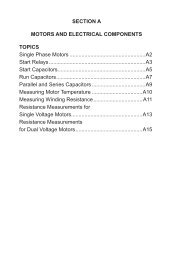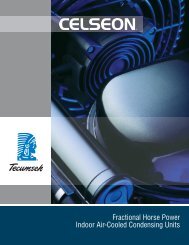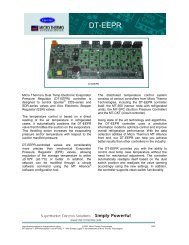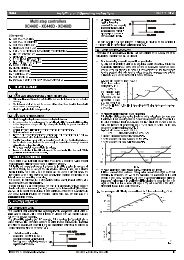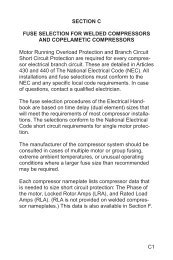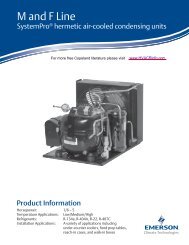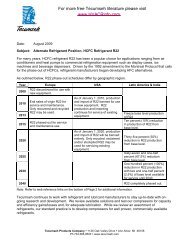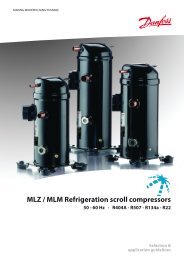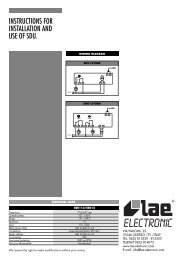The Refrigeration Load - HVAC and Refrigeration Information Links
The Refrigeration Load - HVAC and Refrigeration Information Links
The Refrigeration Load - HVAC and Refrigeration Information Links
You also want an ePaper? Increase the reach of your titles
YUMPU automatically turns print PDFs into web optimized ePapers that Google loves.
a condensing temperature 20°F above the specifiedambient temperature of 100°F., or 120°F. In a similarmanner balance point B can be located by the intersectionof the 25°F. TD condenser capacity curve <strong>and</strong>the compressor capacity curve (estimated) for 125°F.condensing, <strong>and</strong> balance point C can be located by theintersection of the 15°F. TD condenser capacity curvewith the compressor capacity curve (estimated) for115°F. condensing. <strong>The</strong> line connecting points A, B, <strong>and</strong>C represents all the possible balance points when thesystem is operating with air entering the condenser at atemperature of 100°F. In a similar fashion, condensercompressorbalance lines can be determined for otherambient temperatures, <strong>and</strong> plotted as shown in Figure72. (To simplify the illustration, condenser capacitycurves have not been shown)<strong>The</strong> tentative evaporator coil selected was rated bythe manufacturer only in terms of BTU/hr per degreetemperature difference between the entering dry bulbtemperature <strong>and</strong> the refrigerant evaporating temperature,<strong>and</strong> have a capacity of 4,590 BTU/hr/°TD. In Figure73 evaporator capacity curves have been plotted <strong>and</strong>superimposed on the compressor capacity curves <strong>and</strong>the condenser-compressor balance lines. An evaporatorcapacity curve for each entering air temperature can beconstructed by plotting any two points.Point A represents the evaporator capacity at 14°TDwhich for an entering air temperature of 40°F. wouldrequire a refrigerant evaporating temperature of 26°F.However, an allowance must be made for line frictionlosses since the pressure in the evaporator will alwaysbe higher than the suction pressure at the compressorbecause of pressure drop in the suction line. Allowing2°F. as an estimated allowance for line pressure drop,an evaporating temperature of 26°F. would result in apressure at the compressor equivalent to a saturatedevaporating temperature of 24°F. <strong>The</strong>refore the capacityof the evaporator for a 14° TD <strong>and</strong> 40°F. enteringair would be plotted at the corresponding compressorcapacity at 24°F.Point B represents the evaporator capacity at 10°TD, which for 40°F. entering air temperature requiresa refrigerant evaporating temperature of 30°F., <strong>and</strong>after allowing for suction line losses, a correspondingcompressor capacity at 28°F. A line can then be drawnthrough these two points, representing all possiblecapacities of the evaporator with 40°F. entering air<strong>and</strong> varying refrigerant evaporating temperatures. In asimilar fashion, capacity curves can be constructed forother entering air temperatures.<strong>The</strong> system performance can now be forecast for anycondition of evaporator entering air temperature <strong>and</strong>ambient temperature. With 100°F. ambient temperature<strong>and</strong> an evaporator entering air temperature of 40°F.,the original design conditions, the system would havea capacity of 59,000 BTU/hr, a compressor suctionpressure equivalent to an evaporating temperature of26°F., <strong>and</strong> a condensing temperature of 120°F. Evenunder extreme load conditions of 50°F. entering air <strong>and</strong>110°F. ambient, the condensing temperature would notexceed 133°F. <strong>The</strong>se conditions are close enough tothe original design requirement to insure satisfactoryperformance.This type of graphical analysis can be quickly <strong>and</strong> easilymade by using the compressor specification sheetas the basic chart, <strong>and</strong> superimposing condenser <strong>and</strong>evaporator capacity curves.THE EFFECT OF CHANGE IN COMPRESSORONLY ON SYSTEM BALANCEOccasionally the exact replacement compressor maynot be available, <strong>and</strong> the question arises as to whetheran alternate compressor with either more or less capacitymight provide satisfactory performance. <strong>The</strong>graphical balance chart provides a convenient meansof forecasting system performance.Figure 74 is a revised balance chart for a system utilizingthe same evaporator <strong>and</strong> condenser as in the previousexample, but with a compressor having only 5/6 of theprevious capacity. New compressor capacity curves forthe smaller compressor have been plotted on the samecapacity chart used previously. Since there is no changein the basic capacity of the condenser or evaporator,the condenser capacity <strong>and</strong> evaporator capacity curvesare unchanged.However, a new compressor-condenser balance linemust be plotted, <strong>and</strong> to avoid excessive detail in the illustration,a balance line for 100° ambient temperatureonly has been shown.A comparison can now be made between the systemwith the original compressor, Figure 73, <strong>and</strong> the systemwith the smaller compressor, Figure 74.Original RevisedSystem SystemAmbient Temperature 100°F. 100°F.Air Entering Evaporator 40°F. 40°F.Refrigerant EvaporatingTemp. 26°F. 27°F.Condensing Temperature 120°F. 115°F.Capacity at 100°F. Ambient<strong>and</strong> 40°F. Entering Air,BTU/hr. 59,000 53,000(continued on p. 16-11)16-9© 1968 Emerson Climate Technologies, Inc.All rights reserved.



